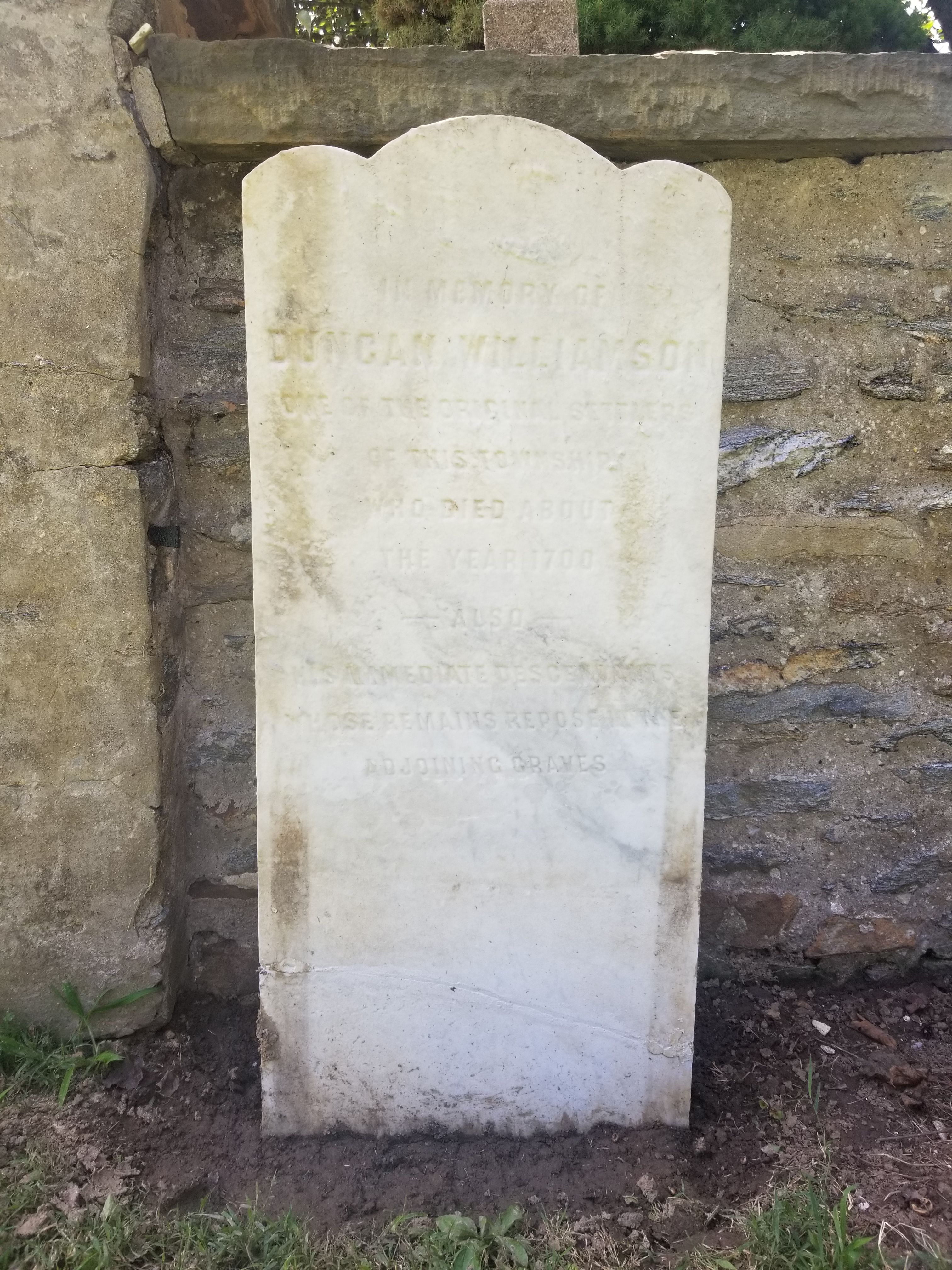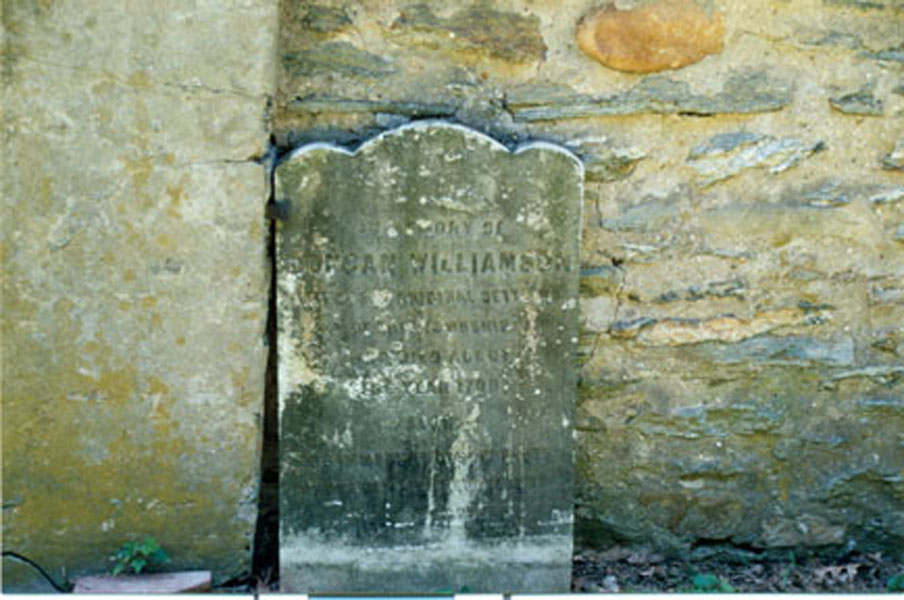"Located on Lerch Road in the Glen Ashton section of Bensalem is the private cemetery of the Williamson and Johnson families. Both were early settlers of Bensalem Township. Now maintained by the Historical Society of Bensalem Township, it contains a memorial marker dedicated to Duncan Williamson. However, Duncan is buried in the Gloria Dei (Old Swedes) Church cemetery in Philadelphia."
History of Bucks County, Pa Volume 3 by William H. Davis
THE WILLIAMSON FAMILY. The history of this family takes us back to the period prior to the grant of Pennsylvania to William PENN and possibly to two or three decades prior to that date when the representatives of three Eureopean [sic] nations were battling for supremacy on the shores of our middle states. The Swedes made the first organized settlement on Pennsylvania soil in 1638 under Peter MINUIT. The Dutch began almost immediately to contest their supremacy there, and from the time of the conquest of the Swedes by the Hollanders, two decades later, until the subsequent conquest of the latter by the English, representatives of the Anglo-Saxon and Celtic races began to make their appearance on the Delaware. The earliest records of the court at Upland (now Chester) under English jurisdiction in 1676, show a number of names of undoubted English origin, though the first justices were all Swedes.
Dunck WILLIAMES, as his name is usually spelled in the earlier records, though it appears in various forms both as to first and surname, during his whole life was the founder of the family of WILLIAMSON in Pennsylvania. He is claimed by his descendants to have been of Swedish or Holland origin, but many circumstances in connection with his first appearance on Pennsylvania soil strongly indicate to the writer of these lines that he was of English or Scotch origin. The most significant of these is the fact that he was associated in his first purchase of land with Francis WALKER, whose name clearly indicates that he was of neither Dutch or Swedish origin. Again, hereditary surnames were unknown in either Sweden or Holland until late in the sixteenth century and their representatives in America were known by their father's given name, with the addition of "es" or "se." [SIC] Had he therefore been of Dutch origin his name would have been more probably Gulliamse, if his father was named WILLIAM, and the name WILLIAN was practically unknown among the Swedes. The name DUNCK or DUNK was doubtless a contraction of DUNCAN, and in neither form has ever been found among the Swedes or Dutch [SIC] Just when Dunk WILLIAMSON arrived on the Delaware is a matter of some conjecture.
As early as 1667 Dunk WILLIMS and eight others secured from Governor Richard NICOLLS a patent for a tract of land of one thousand acres, known as Passayunk, indicating that he was one of the first settlers to secure title to land in what is now Philadelphia, from the English rulers who conquered the territory in 1664. His grant of land, in connection with Francis WALKER, under patent from Sir Edmund ANDROSS under date of July 18, 1676, comprehended 450 acres on the Neshaminy in the present limits of Bensalem township, comprising the present site of Dunks Ferry, named for him. "Franck WALKER," first appears of record at Upland as the custodian of goods belonging to Captain Edward CANTWELL, who administered the oaths to the first justices at Upland in 1676.
On a "List of Tydable persons under the jurisdiction of ye Court," made November 13, 1677, the names of "Dunk WILLIAMES" and "Franck WALKER" appear in the district of Taokanink (Tacony), and on November 12, 1678, Dunk WILLIAMS petitioned to take up one hundred acres of land "on the lower syde of Nieshambenies (Neshaminy) creek, 50 acres thereof at ye river syde & ye other 50 acres up in the woods;" This was therefore at the mouth of Neshaminy in Bensalem. He also served on a jury at the same date.
On March 12, 1678-79, he petitioned to take up four acres of marsh back of his "plantaceion." On the latter date Edmund DRAUFTON brought suit against him for the tuition of his children, showing that at that early date of Pennsylvania colonists were interested in the education of their youth. The title of WILLIAMSON and WALKER to the tract of land in Bucks county was confirmed by PENN, and the former became a large landowner.
The will of Dunck WILLIAMSON, dated February 12, 1607-8, and probated March 1, 1699-1700, mentions his wife, Wallery, sons William and John WILLIAMSON, and daughters, Hanns, wife of John GOUND, and Margared, wife of John JOHNSON. To John he devises 500 acres of land in the bounds of Cohanset. (Cohansey, Salem county, New Jersey), to Hanna GOUND, one hundred acres in the county of Kent; to Margred JOHNSON, five pounds or its equivalent; and to William, all his estate in Pennsylvania.
"Located on Lerch Road in the Glen Ashton section of Bensalem is the private cemetery of the Williamson and Johnson families. Both were early settlers of Bensalem Township. Now maintained by the Historical Society of Bensalem Township, it contains a memorial marker dedicated to Duncan Williamson. However, Duncan is buried in the Gloria Dei (Old Swedes) Church cemetery in Philadelphia."
History of Bucks County, Pa Volume 3 by William H. Davis
THE WILLIAMSON FAMILY. The history of this family takes us back to the period prior to the grant of Pennsylvania to William PENN and possibly to two or three decades prior to that date when the representatives of three Eureopean [sic] nations were battling for supremacy on the shores of our middle states. The Swedes made the first organized settlement on Pennsylvania soil in 1638 under Peter MINUIT. The Dutch began almost immediately to contest their supremacy there, and from the time of the conquest of the Swedes by the Hollanders, two decades later, until the subsequent conquest of the latter by the English, representatives of the Anglo-Saxon and Celtic races began to make their appearance on the Delaware. The earliest records of the court at Upland (now Chester) under English jurisdiction in 1676, show a number of names of undoubted English origin, though the first justices were all Swedes.
Dunck WILLIAMES, as his name is usually spelled in the earlier records, though it appears in various forms both as to first and surname, during his whole life was the founder of the family of WILLIAMSON in Pennsylvania. He is claimed by his descendants to have been of Swedish or Holland origin, but many circumstances in connection with his first appearance on Pennsylvania soil strongly indicate to the writer of these lines that he was of English or Scotch origin. The most significant of these is the fact that he was associated in his first purchase of land with Francis WALKER, whose name clearly indicates that he was of neither Dutch or Swedish origin. Again, hereditary surnames were unknown in either Sweden or Holland until late in the sixteenth century and their representatives in America were known by their father's given name, with the addition of "es" or "se." [SIC] Had he therefore been of Dutch origin his name would have been more probably Gulliamse, if his father was named WILLIAM, and the name WILLIAN was practically unknown among the Swedes. The name DUNCK or DUNK was doubtless a contraction of DUNCAN, and in neither form has ever been found among the Swedes or Dutch [SIC] Just when Dunk WILLIAMSON arrived on the Delaware is a matter of some conjecture.
As early as 1667 Dunk WILLIMS and eight others secured from Governor Richard NICOLLS a patent for a tract of land of one thousand acres, known as Passayunk, indicating that he was one of the first settlers to secure title to land in what is now Philadelphia, from the English rulers who conquered the territory in 1664. His grant of land, in connection with Francis WALKER, under patent from Sir Edmund ANDROSS under date of July 18, 1676, comprehended 450 acres on the Neshaminy in the present limits of Bensalem township, comprising the present site of Dunks Ferry, named for him. "Franck WALKER," first appears of record at Upland as the custodian of goods belonging to Captain Edward CANTWELL, who administered the oaths to the first justices at Upland in 1676.
On a "List of Tydable persons under the jurisdiction of ye Court," made November 13, 1677, the names of "Dunk WILLIAMES" and "Franck WALKER" appear in the district of Taokanink (Tacony), and on November 12, 1678, Dunk WILLIAMS petitioned to take up one hundred acres of land "on the lower syde of Nieshambenies (Neshaminy) creek, 50 acres thereof at ye river syde & ye other 50 acres up in the woods;" This was therefore at the mouth of Neshaminy in Bensalem. He also served on a jury at the same date.
On March 12, 1678-79, he petitioned to take up four acres of marsh back of his "plantaceion." On the latter date Edmund DRAUFTON brought suit against him for the tuition of his children, showing that at that early date of Pennsylvania colonists were interested in the education of their youth. The title of WILLIAMSON and WALKER to the tract of land in Bucks county was confirmed by PENN, and the former became a large landowner.
The will of Dunck WILLIAMSON, dated February 12, 1607-8, and probated March 1, 1699-1700, mentions his wife, Wallery, sons William and John WILLIAMSON, and daughters, Hanns, wife of John GOUND, and Margared, wife of John JOHNSON. To John he devises 500 acres of land in the bounds of Cohanset. (Cohansey, Salem county, New Jersey), to Hanna GOUND, one hundred acres in the county of Kent; to Margred JOHNSON, five pounds or its equivalent; and to William, all his estate in Pennsylvania.




